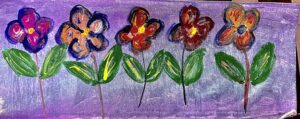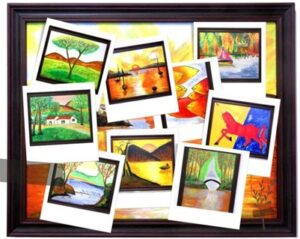THE HIDDEN HEALING POWER OF MEDITATION – WHY PAINTING IS A FORM OF MEDITATION AND MINDFULNESS?
Did you know that painting can be a form of meditation and mindfulness? If you’re not already aware of the benefits of painting, this article is here to change your mind. Painting can help you de-stress and focus. It can help you regain your balance and find inner peace. Painting allows you to clear your mind, quiet your thoughts, and relieve stress. With so many benefits, it’s no wonder so many people paint.

Painting can also help you relieve stress, lower blood pressure, and improve your immune system? Or that it can reduce the symptoms of stress, depression, and anxiety? Nope, us neither. But it’s true! Painting is more than just a hobby—it’s an art form with therapeutic benefits. Painting has the power to relieve stress, lower blood pressure, and improve your immune system. It can also help you ease stress, anxiety, and depression symptoms. When you create art, you tap into your inner self and express your emotions. Painting is a great way to release stress, as it requires visual focus, spatial reasoning, and colour differentiation. When you’re painting, your mind is free to wander and explore without getting distracted. It’s also a great way to know yourself and accept your emotions.

Further, have you ever wondered why so many people enjoy painting? Or why do so many artists insist that painting is among the most fulfilling activities they engage in? Perhaps you’ve considered painting a hobby but aren’t sure if it’s the right fit for you. Or maybe you’ve considered taking painting lessons but have been hesitant to commit to the time and money required. After I took up painting a few years ago, I discovered that painting anchors me in my pursuit for a more profound peace and awareness of the world around me, so painting has become a meditative pastime and an aid to well-being. Painting enables me to connect with my inner being deeply, and it helps me cut out all the noise and distractions and love the small things around me and not always be striving for more.
Neuroscience research reveals painting is akin to meditation
Creating art is similar to meditation, as both use the same brain regions. When we paint, we experience flow states much like meditation, which can help us reach our creative goals. Neuroscience has found that creating art activates the same areas in the brain as meditation does, including the prefrontal cortex, hippocampus, parahippocampal cortex, and visual cortex, all of which play a role in self-reflection and creativity goal setting. So painting activates these same neural pathways as meditation, but in a way, that’s far more accessible to everyone. The art you create can be your self-expression, something you’ve never done before, or a way to explore your emotions.
Why Is Painting a Form of Meditation and Mindfulness?
First and foremost, painting is a meditative activity. It’s a mindful way to connect with yourself, your emotions, and your creative side. It allows you to let go of daily worries—after all, you’re only focusing on one thing, your brush or pencil (or whatever you’re painting with). By meditating on your art, you’re also considering the context of what you’re painting, which leads to more profound thoughts and a more holistic perspective on your work. It also helps you create more nuanced work, as you’re not just relying on your visual senses. With meditation, you’re also tapping into your creativity, something everyone can use more of in their lives.
Painting is more than just a hobby—it’s an art form with therapeutic benefits. We can use it to relieve stress, lower blood pressure, and improve your immune system. It can also help you ease stress, anxiety, and depression symptoms. When you create art, you tap into your inner self and express your emotions. Painting is a great way to release stress, as it requires visual focus, spatial reasoning, and colour differentiation. When you’re painting, your mind is free to wander and explore without getting distracted. It’s also a great way to know yourself and accept your emotions.

Painting is an Artform of Mindfulness
Painting is a form of mindfulness because it connects you with your emotions and helps you accept them. Painting enables you to explore your feelings and express them through creative work. It’s also a great way to de-stress. When you paint, you’re not focusing on the small things that stress you. Instead, you’re taking your focus off of your work and relaxing into the act of creating art. Painting is a type of mindfulness that allows you to settle into your emotions and voices in your head. You can listen to these voices, ignore them, or choose to paint over them. The choice is up to you. You can also use your art to connect with others and share your feelings.
Self-care is a big subject. It seems like everyone is constantly battling stress and exhaustion in our fast-paced world. But taking time for yourself isn’t always easy. The last thing you feel like doing is sitting still and focusing on something that might make you feel uncomfortable. But the benefits of painting extend beyond the walls of your home. It can provide you with a sense of calm, healing, and even mindfulness. Painting is a great stress reliever – it’s fast, cheap, and requires little-to-no set-up.
Painting gets the brain into a flow state
Painting is a flow state type, which happens when you focus on an activity and experience a natural high. You’re in a calm state of mind, and your brain is getting the benefits of a workout. Science proves that getting your brain in a flow state can reduce stress, lower blood pressure, and improve immune function. Getting into a flow state can also make you more creative, benefiting your work as an artist. Research has also found that flow states can help you reach your creative goals. When you’re in a flow state, you’re less distracted and more likely to achieve your goals. Your creativity will improve, making it easier to develop new ideas.
Painting is therapeutic. It heals and de-stresses
As any therapist will tell you, art is therapeutic and can help heal and de-stress. How? First, by creating art, you’re tapping into your creativity. You’re also connecting with your emotions and letting them flow through you. These two aspects of the invention are what all therapists find most beneficial in therapy. When you connect with your creativity, you’ll connect with your emotions. You’re expressing yourself and releasing the pain you’re feeling through your art by painting. Painting can also help you de-stress, as it’s a form of creative expression that doesn’t require follow-through. You’re not doing anything with your hands, so there’s no pressure to make things perfect. Painting, whether while creating or observing, diminishes the stress hormone cortisol. It also secretes the feel-good hormones called endorphins which enable one to combat stress and pain. By letting a person relish a sense of fulfilment, it transforms him into a more optimistic, well-rounded human being.

Conclusion
When we think of art and painting, we tend to think of it as an activity reserved for the more artistic minds among us. That is a significant misconception, as artwork touches on many different facets of our personality. Not only does it engage our senses, as it requires us to observe, analyse and synthesise colours, but it also helps to boost our emotions and our mental faculties. Art is a critical component of mental wellness, as it is a means of self-expression with the potential to impact anyone who engages with it positively. The practice of painting is no exception, as painting has many therapeutic benefits. It is a form of self-care that allows us to escape from the pressures of the outside world and reconnect with our inner creativity. When you immerse yourself in painting, you realise the tremendous healing power of painting and how it can help you find inner peace and balance. Painting can also be a form of meditation and mindfulness as it enables you to connect with yourself and lets you express your emotions, relax, and de-stress.
 Dr.K. Jayanth Murali is an IPS Officer belonging to 1991 batch. He is borne on Tamil Nadu cadre. He lives with his family in Chennai, India. He is currently serving the Government of Tamil Nadu as Director General of Police, Idol Wing CID.
Dr.K. Jayanth Murali is an IPS Officer belonging to 1991 batch. He is borne on Tamil Nadu cadre. He lives with his family in Chennai, India. He is currently serving the Government of Tamil Nadu as Director General of Police, Idol Wing CID.


